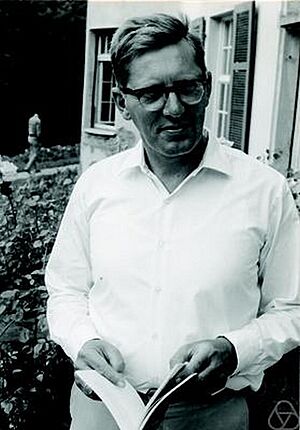Nicolaas Govert de Bruijn facts for kids
Quick facts for kids
Nicolaas Govert de Bruijn
|
|
|---|---|
 |
|
| Born | 9 July 1918 |
| Died | 17 February 2012 (aged 93) Nuenen
|
| Nationality | Dutch |
| Alma mater | Vrije Universiteit Amsterdam |
| Known for | Automath BEST theorem De Bruijn factor De Bruijn index De Bruijn graph De Bruijn notation De Bruijn sequence De Bruijn's theorem De Bruijn torus De Bruijn–Erdős theorem De Bruijn–Erdős theorem (geometry) de Bruijn–Newman constant Dickman–de Bruijn function Moser–de Bruijn sequence |
| Scientific career | |
| Fields | Mathematics |
| Institutions | Eindhoven University of Technology |
| Doctoral advisor | Jurjen Ferdinand Koksma |
| Doctoral students | Johannes Runnenburg Stan Ackermans |
Nicolaas Govert "Dick" de Bruijn (born 9 July 1918 – died 17 February 2012) was a famous Dutch mathematician. He made many important discoveries in different areas of math. These areas include analysis, number theory, combinatorics (the study of counting and arrangements), and logic.
Contents
A Look at His Life
Nicolaas de Bruijn was born in The Hague, a city in the Netherlands. He went to elementary school there from 1924 to 1930. After that, he attended secondary school until 1934.
His Education and Early Career
In 1936, he started studying mathematics at Leiden University. However, his studies were stopped when World War II began in 1939. Even with the war, he kept learning.
In September 1939, he became a full-time assistant. This was in the math department at the Technological University of Delft. He finished his first university degree at Leiden University in 1941. He earned his PhD in 1943 from the Vrije Universiteit Amsterdam. His main teacher for his PhD was Jurjen Ferdinand Koksma.
From June 1944, he worked as a scientist. He was at the Philips Research Laboratories in Eindhoven.
His Family Life
Nicolaas de Bruijn married Elizabeth de Groot on August 30, 1944. They had four children together. Their names were Jorina Aleida, Frans Willem, Elisabeth, and Judith Elizabeth.
His Teaching Career
De Bruijn began his teaching career at the University of Amsterdam. He was a Professor of Mathematics there from 1952 to 1960.
In 1960, he moved to the Technical University Eindhoven. He continued as a Professor of Mathematics until he retired in 1984. He taught many students who went on to earn their own PhDs. Some of his students included Johannes Runnenburg and Stan Ackermans.
Awards and Recognition
In 1957, Nicolaas de Bruijn became a member of the Royal Netherlands Academy of Arts and Sciences. This is a very respected group of scientists and artists. He was also honored as a Knight of the Order of the Netherlands Lion. This is a special award in the Netherlands.
What Did He Discover?
De Bruijn worked on many different parts of mathematics. He is especially known for several important discoveries.
- De Bruijn sequence: This is a special type of sequence (a list of numbers or symbols) that has interesting properties.
- Penrose tiling: He found an algebraic theory for the Penrose tiling. This is a way to cover a flat surface with shapes that never repeat in a regular pattern. He also found ways to build these "quasi-periodic" patterns.
- De Bruijn–Newman constant: This is a special number in mathematics that is still being studied today.
- De Bruijn–Erdős theorem: He helped create two different important theorems with mathematician Paul Erdős.
- One is in graph theory, which studies networks of points and lines.
- The other is in incidence geometry, which looks at how points and lines meet.
- BEST theorem: This is another important theorem in graph theory.
- De Bruijn indices: These are used in computer science and logic. They help to keep track of variables in computer programs or mathematical proofs.
He also wrote an important book in 1958 about asymptotic analysis. This is a part of math that studies how functions behave when numbers get very large.
Automath and Other Ideas
In the late 1960s, he created a special computer language called Automath. This language was designed to write mathematical proofs. It allowed computers to check if the proofs were correct automatically. This was a big step for automated theorem checking.
Before he passed away, he was working on ideas about how the human brain works.
Images for kids


